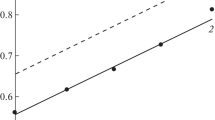Abstract
The dynamics of variations in the currentless potential of a lead electrode in 2 M solution of sulfuric acid after cathode treatment by liberating hydrogen is studied. It is shown that, in the course of cathodic polarization, the liberation of hydrogen is accompanied by the formation of a film of lead sulfates due to corrosion that occurs on the metal surface. The major component of the measured potential is the voltage drop in the sulfate film. Two explanations for the simultaneous occurrence of the processes of hydrogen liberation and lead corrosion, which is impossible from the viewpoint of thermodynamics, are proposed. The first explanation is based on the electrical nonuniformity of the surface, which results from current localization at single active points (microzones), and on the absence of a protective cathodic potential at a distance from these points. The second explanation involves the voltage drop in the sulfate film, which is the component of the potential measured at the film–electrolyte interface. At the metal–film interface, the anodic polarization of the metal surface can occur, while nominally cathodic polarization takes place. Upon current interruption, the intricate processes of the growth and recrystallization of the sulfate film accompanied by the stepwise passivation of lead continue to occur. The limiting process for the corrosion system is the anodic reaction of the dissolution of lead.
Similar content being viewed by others
References
D’Alkainea, C.V., de Souzab, L.L., and de Britoc, G., Solid state reactions at metal/film interfaces: The case of the Pb/PbSO4 interface, J. Power Sources, 2012, vol. 210, pp. 218–223.
Ebnera, E., Buro, D., Börgera, A., Warkc, M., Atanassovad, P., and Valencianoe, J., Carbon blacks for the extension of the cycle life in flooded lead acid batteries for micro-hybrid applications, J. Power Sources, 2013, vol. 239, pp. 483–489.
Jiayuan, Xiang, Ping, Ding, Hao, Zhang, Xianzhang, Wu, Jian, Chen, and Yusheng, Yang, Beneficial effects of activated carbon additives on the performance of negative lead-acid battery electrode for high-rate partial-state-of-charge operation, J. Power Sources, 2013, vol. 241, pp. 150–158.
Pavlov, D. and Nikolov, P., Capacitive carbon and electrochemical lead electrode systems at the negative plates of lead-acid batteries and elementary processes on cycling, J. Power Sources, 2013, vol. 242, pp. 380–399.
Koshel’, N.D., Gerasika, N.S., and Kostyrya, M.V., The effect of hydrogen treatment of lead surface on its electrochemical behavior, Surf. Eng. Appl. Electrochem., 2014, vol. 50, no. 2, pp. 117–124.
Fletcher, S. and Matthews, D.B., Behavior of lead electrodes in sulphate electrolytes. I. Effect of electrode preparation on discriminate curve cyclic voltammograms, J. Appl. Electrochem., 1981, vol. 11, pp. 11–21.
Fletcher, S. and Matthews, D.B., Behavior of lead electrodes in sulphate electrolytes. II. Investigation of the electrode kinetics, J. Appl. Electrochem., 1981, vol. 11, pp. 23–32.
Spravochnik khimika (Chemist Reference Book), Moscow: Khimiya, 1966, vol. 1.
Spravochnik khimika (Chemist Reference Book), Moscow: Khimiya, 1966, vol. 3.
Garche, J., Mitchell, P.J., and Hampson, N.A., Reactions at lead electrodes in 5 mol dm–3 H2SO4 near the equilibrium potential, J. Appl. Electrochem., 1984, vol. 14, pp. 97–106.
Author information
Authors and Affiliations
Corresponding author
Additional information
Original Russian Text © N.D. Koshel, N.S. Gerasika, M.V. Kostyrya, 2016, published in Elektronnaya Obrabotka Materialov, 2016, No. 1, pp. 22–30.
About this article
Cite this article
Koshel, N.D., Gerasika, N.S. & Kostyrya, M.V. Nonstationary processes that occur on nonpolarizable lead surface in sulfuric acid. Surf. Engin. Appl.Electrochem. 52, 23–31 (2016). https://doi.org/10.3103/S1068375516010099
Received:
Published:
Issue Date:
DOI: https://doi.org/10.3103/S1068375516010099




